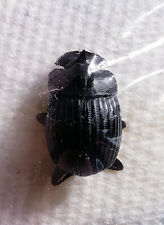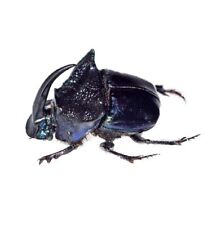Dung Beetle Liatongus gagatinus 60 mm Sphere Ball Vechicle Shift Knob Clear For Sale

When you click on links to various merchants on this site and make a purchase, this can result in this site earning a commission. Affiliate programs and affiliations include, but are not limited to, the eBay Partner Network.
Dung Beetle Liatongus gagatinus 60 mm Sphere Ball Vechicle Shift Knob Clear:
$19.99
Nature & Science
Dung Beetle Liatongus gagatinus 60 mm Sphere Ball Vechicle Shift Knob ClearVehicle Shift Knob – embedded with real animal specimen
-- 60 mm (2.4 inch) Diameter Sphere with 15 x 16 mm (width x depth) Master brass insert Threads.
Real Dung Beetle (Liatongus gagatinus) specimen encased in clear lucite material. The specimen is crystal clear, transparent and indestructible. Safe, authentic and completely unbreakable product putreal Beetle right at your fingertips!
Anyone can safely explore the Beetle from different angles.
Length of the beetle body is 46 mm (1.8 inch).
Diameter of the sphereis 60 mm (2.4 inches).
Weight of thesphere is 160 gram and 190 gram with a cardboard packing box.
It is a very good collectible item for every body.
This is a handmade real animal specimen craft. Each one will be a bit different (specimen size, color and posture) even in the same production batch.
The picture in the listing is just for reference as we are selling multiple pieces with same cost:
Free shipping cost.
We send the goods to USA, UK and Australia buyers by E-express, a kind of postal express service set up by Hong Kong Post. It usually takes about 8 to 12 working days for delivery.
We send the goods to other countries by registered airmail through Hong Kong Post. It usually takes about 15 to 20 working days for delivery, and it may take a bit longer to Central and South Beetle - Liatongusgagatinus
Order: Coleoptera
Family: Scarabaeidae
Genus: Liatongus
Body size: 28 - 40 mm
Black body color. Head in front of a clear shield-shaped. Chest and back on both sides of the front angle with small horn. Adult mature from May to Aug.
Distribution: China, Vietnam, Cambodia, Burma, Nepal and India
The Dung Beetles are Scarabs belonging to the subfamily Coprinae, and their habit is to collect a ball of dried dung (from cattle or wild ungulates) and to roll it along with their hind legs to a special breeding tunnel dug in the earth. The dung ball is pushed down inside the tunnel and at the end the breeding chamber may contain several dung balls, each with an egg laid alongside it. Some of the balls of dung are used as food for the adults. Usually the female beetle guards the “nest” for some while. But in most species she dies soon after egg-laying.
The dung beetles include several subfamilies of the large family Scarabaeidae, the scarab beetles. There are thousands of species of dung beetles, occurring worldwide wherever dung is found. Adults range from 2 to over 50 mm in length. Most species are dark colored, but a few have bright patterns or even metallic colors. Many species have distinctive horns or other processes. Some species of dung beetle prefer certain habitats (e.g. grassland or forest) or certain soil types (e.g. sand or clay). Some species feed on dung of only one species of animal, while others are less choosy. Most eat dung, but some scavenge carcasses or feed in decaying vegetation or fungi. Both adults and larvae feed on the food source. Some species shape a brood ball which they roll away to bury, while others simply dig burrows under or near the food and pack it into them. The pictures above show one such brood ball, both whole (upper left) and cut-away to reveal the larva inside.
As can be expected, dung beetles are found in or near the dung of various animals. Utilization of dung varies between species. The females of some species roll a ball of dung which has been cut from the pat by means of the shovel-like front part of the head and then shaped and compacted into a ball using the stout front legs.
The ball is rolled away from the dung mass and then buried, either to be eaten by the adult or stored as food for the larva, which hatches out from a single egg laid in the dung.
Other species excavate a chamber immediately below the dung pat, pack it with dung and lay several eggs in it.
Eggs are normally laid in special cells or hollows constructed in the dung. The feeding activities of the larvae eventually produce larger hollow dry shells in which they pupate.
Some of the larger dung beetles (Heliocopris) pack a layer of clay around the dung ball to protect the food source of their prospective larvae. These clay balls can reach the size of a cricket ball and are almost indestructable.
Item SpecificsCountry of Manufacture ChinaMaterial ResinType OrnamentCountry/Region of Manufacture ChinaUPC Does not apply
Payment by Paypal
Payment: By Paypal
Free shipping costGoods will be sent by airmail through Post Office from Hong Kong and it may take 12 -18 working days to arrive, and it may take a bit longer to Central and South America.
For items over US$5 in value, we will send the goods to USA buyers by E-express, a kind of postal express service set up by with USPS and Hong Kong Post. It usually takes about 6 to 10 working days(depends on proximity to USPS international hubs) for delivery in USA.
Returns in 30 days full refundFull refund for returns in 30 days.
Answer message in 24 hoursWe will answer buyer messages within 24 hours.
Policy 5We ship our goods worldwide.
Nature & Science
Vehicle Shift Knob – embedded with real animal specimen
-- 60 mm (2.4 inch) Diameter Sphere with 15 x 16 mm (width x depth) Master brass insert Threads.
Real Dung Beetle (Liatongus gagatinus) specimen encased in clear lucite material. The specimen is crystal clear, transparent and indestructible. Safe, authentic and completely unbreakable product putreal Beetle right at your fingertips!
Anyone can safely explore the Beetle from different angles.
Length of the beetle body is 46 mm (1.8 inch).
Diameter of the sphereis 60 mm (2.4 inches).
Weight of thesphere is 160 gram and 190 gram with a cardboard packing box.
It is a very good collectible item for every body.
This is a handmade real animal specimen craft. Each one will be a bit different (specimen size, color and posture) even in the same production batch.
The picture in the listing is just for reference as we are selling multiple pieces with same cost:
Free shipping cost.
We send the goods to USA, UK and Australia buyers by E-express, a kind of postal express service set up by Hong Kong Post. It usually takes about 8 to 12 working days for delivery.
We send the goods to other countries by registered airmail through Hong Kong Post. It usually takes about 15 to 20 working days for delivery, and it may take a bit longer to Central and South Beetle - Liatongusgagatinus
Order: Coleoptera
Family: Scarabaeidae
Genus: Liatongus
Body size: 28 - 40 mm
Black body color. Head in front of a clear shield-shaped. Chest and back on both sides of the front angle with small horn. Adult mature from May to Aug.
Distribution: China, Vietnam, Cambodia, Burma, Nepal and India
The Dung Beetles are Scarabs belonging to the subfamily Coprinae, and their habit is to collect a ball of dried dung (from cattle or wild ungulates) and to roll it along with their hind legs to a special breeding tunnel dug in the earth. The dung ball is pushed down inside the tunnel and at the end the breeding chamber may contain several dung balls, each with an egg laid alongside it. Some of the balls of dung are used as food for the adults. Usually the female beetle guards the “nest” for some while. But in most species she dies soon after egg-laying.
The dung beetles include several subfamilies of the large family Scarabaeidae, the scarab beetles. There are thousands of species of dung beetles, occurring worldwide wherever dung is found. Adults range from 2 to over 50 mm in length. Most species are dark colored, but a few have bright patterns or even metallic colors. Many species have distinctive horns or other processes. Some species of dung beetle prefer certain habitats (e.g. grassland or forest) or certain soil types (e.g. sand or clay). Some species feed on dung of only one species of animal, while others are less choosy. Most eat dung, but some scavenge carcasses or feed in decaying vegetation or fungi. Both adults and larvae feed on the food source. Some species shape a brood ball which they roll away to bury, while others simply dig burrows under or near the food and pack it into them. The pictures above show one such brood ball, both whole (upper left) and cut-away to reveal the larva inside.
As can be expected, dung beetles are found in or near the dung of various animals. Utilization of dung varies between species. The females of some species roll a ball of dung which has been cut from the pat by means of the shovel-like front part of the head and then shaped and compacted into a ball using the stout front legs.
The ball is rolled away from the dung mass and then buried, either to be eaten by the adult or stored as food for the larva, which hatches out from a single egg laid in the dung.
Other species excavate a chamber immediately below the dung pat, pack it with dung and lay several eggs in it.
Eggs are normally laid in special cells or hollows constructed in the dung. The feeding activities of the larvae eventually produce larger hollow dry shells in which they pupate.
Some of the larger dung beetles (Heliocopris) pack a layer of clay around the dung ball to protect the food source of their prospective larvae. These clay balls can reach the size of a cricket ball and are almost indestructable.
Item SpecificsCountry of Manufacture ChinaMaterial ResinType OrnamentCountry/Region of Manufacture ChinaUPC Does not apply Payment by Paypal
Payment: By Paypal
Free shipping costGoods will be sent by airmail through Post Office from Hong Kong and it may take 12 -18 working days to arrive, and it may take a bit longer to Central and South America.
For items over US$5 in value, we will send the goods to USA buyers by E-express, a kind of postal express service set up by with USPS and Hong Kong Post. It usually takes about 6 to 10 working days(depends on proximity to USPS international hubs) for delivery in USA.
Returns in 30 days full refundFull refund for returns in 30 days.
Answer message in 24 hoursWe will answer buyer messages within 24 hours.
We ship our goods worldwide.
Copy rights of All right reserved.
Powered by SoldEazy
Track Page Views With
Auctiva\'s FREE CounterEvery buyer gets a MyStoreRewards invitation for cash back

Related Items:
Dung Beetle: Copris fricator (Scarabaeidae) USA Coleoptera
$6.50
Phanaeus mexicanus male ONE REAL RED GREEN HORNED DUNG BEETLE
$6.00
Phanaeus quadridens ONE REAL BLUE HORNED DUNG BEETLE Guatemala PINNED
$8.00



